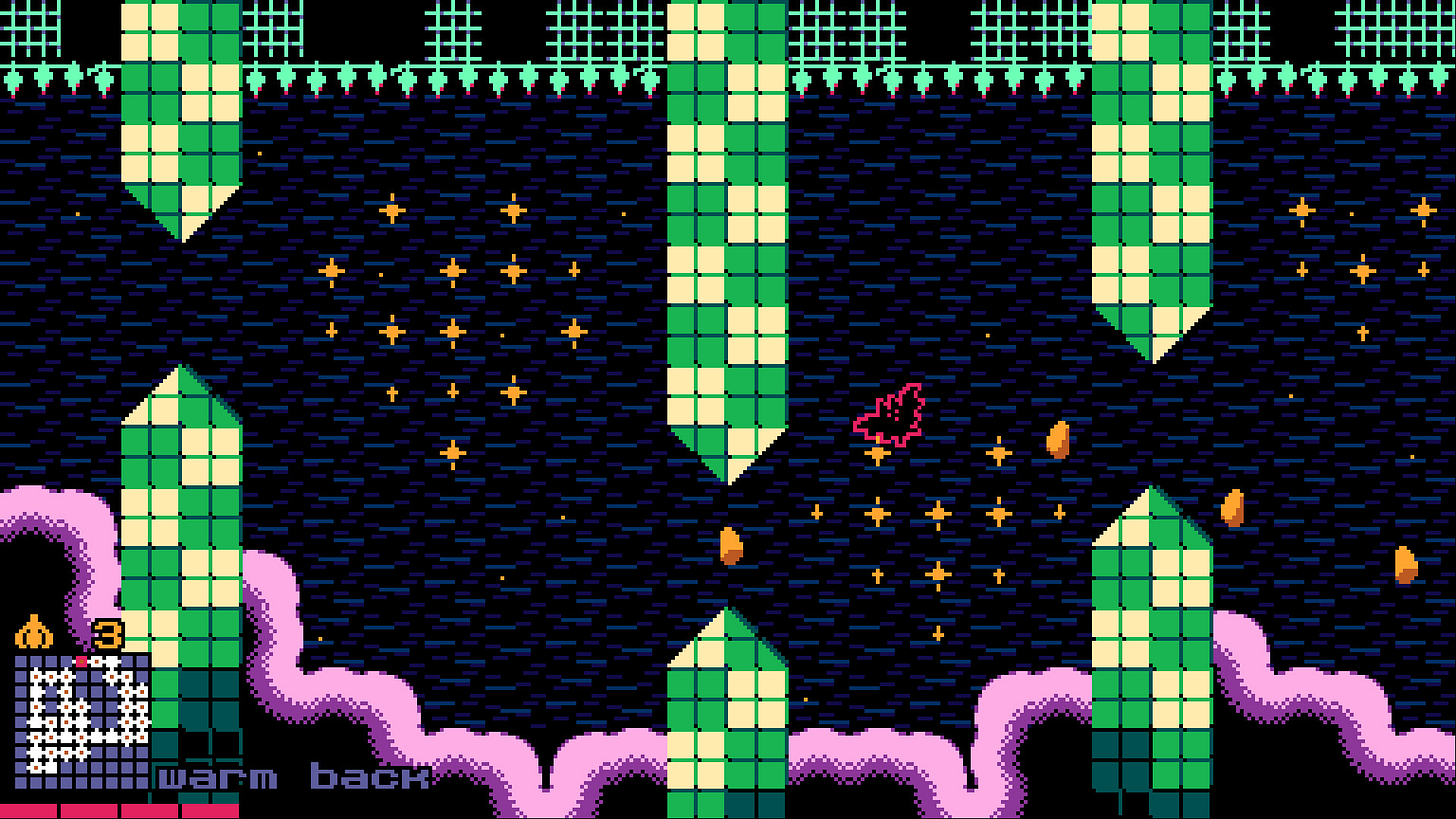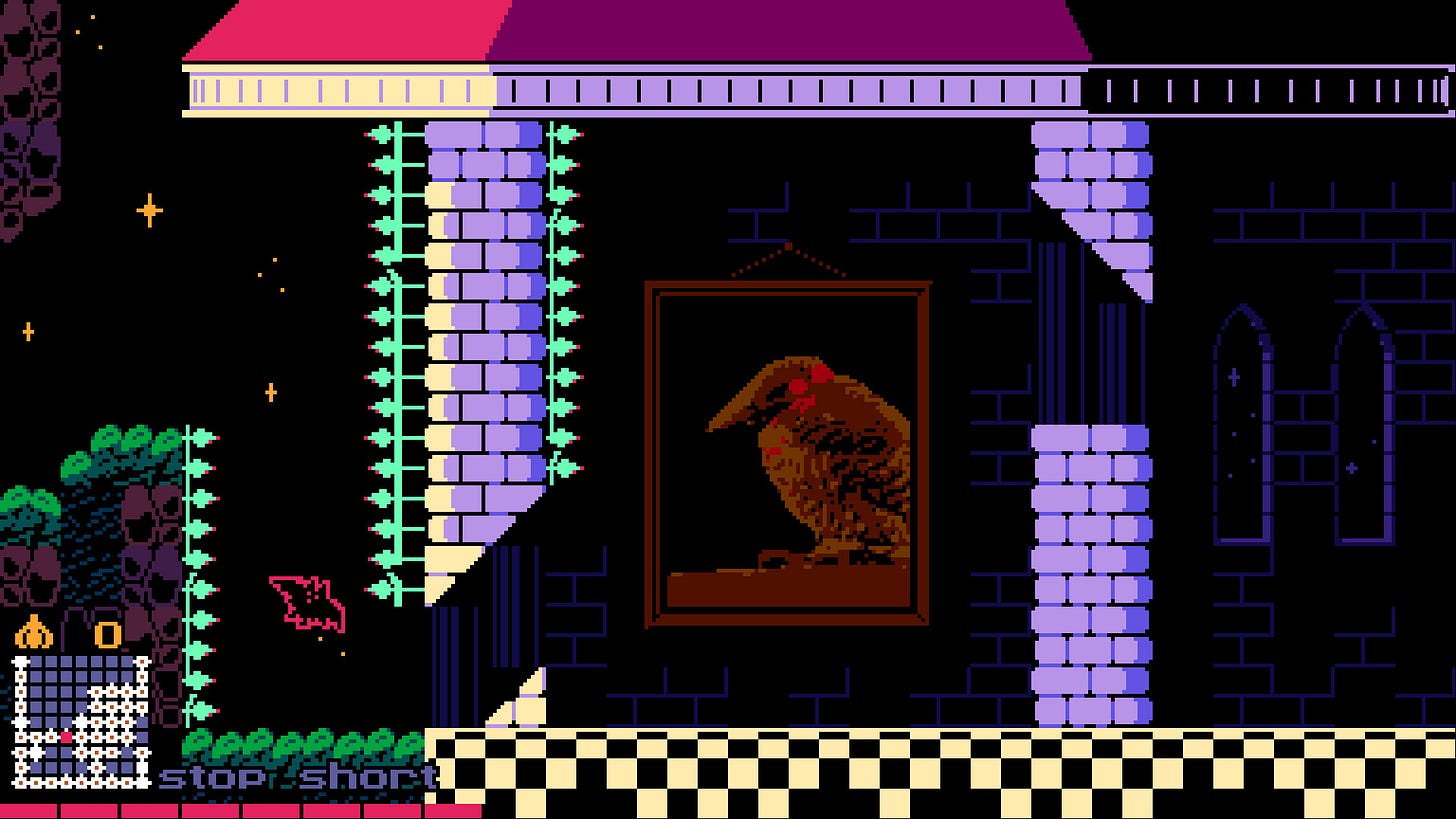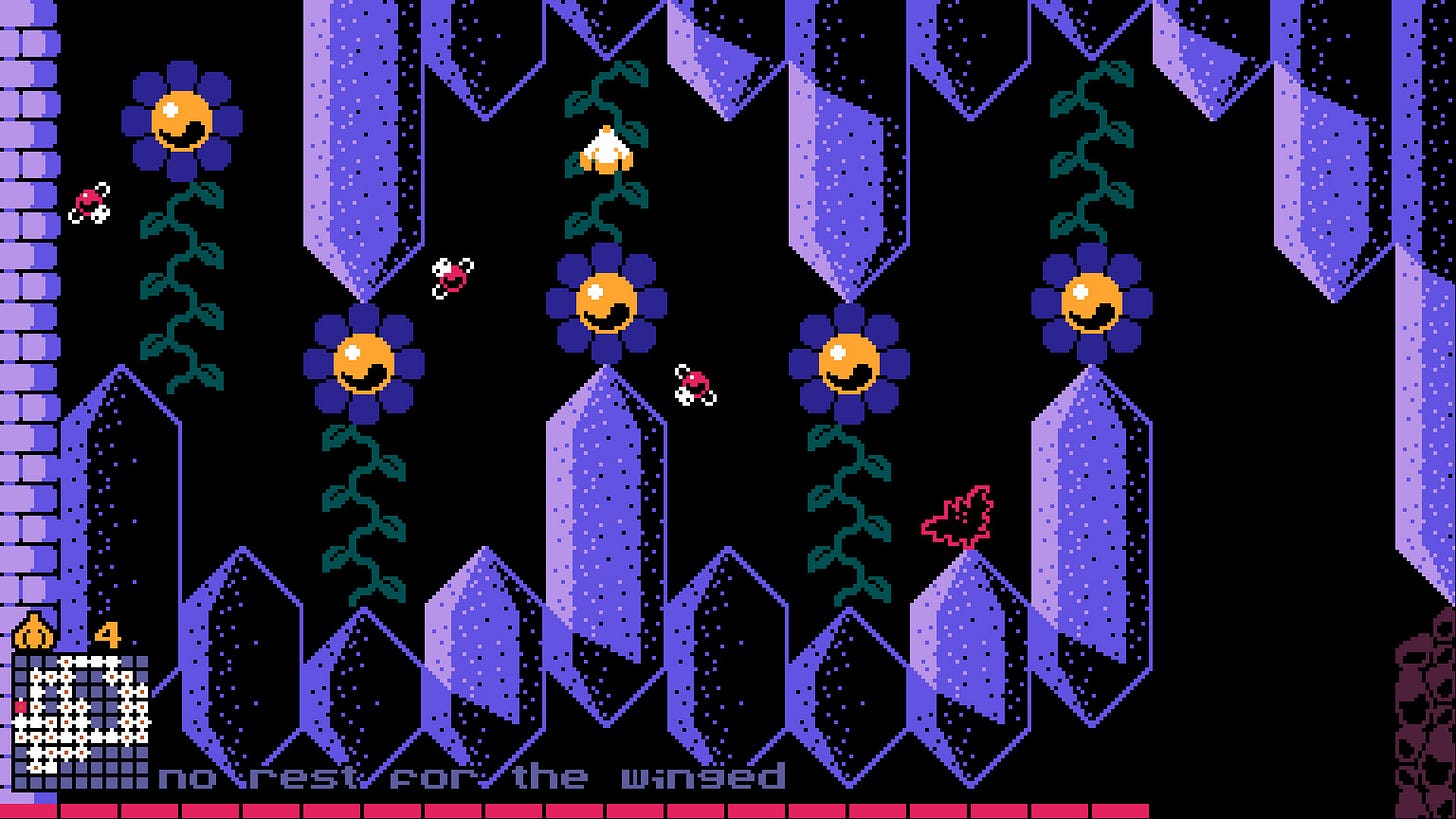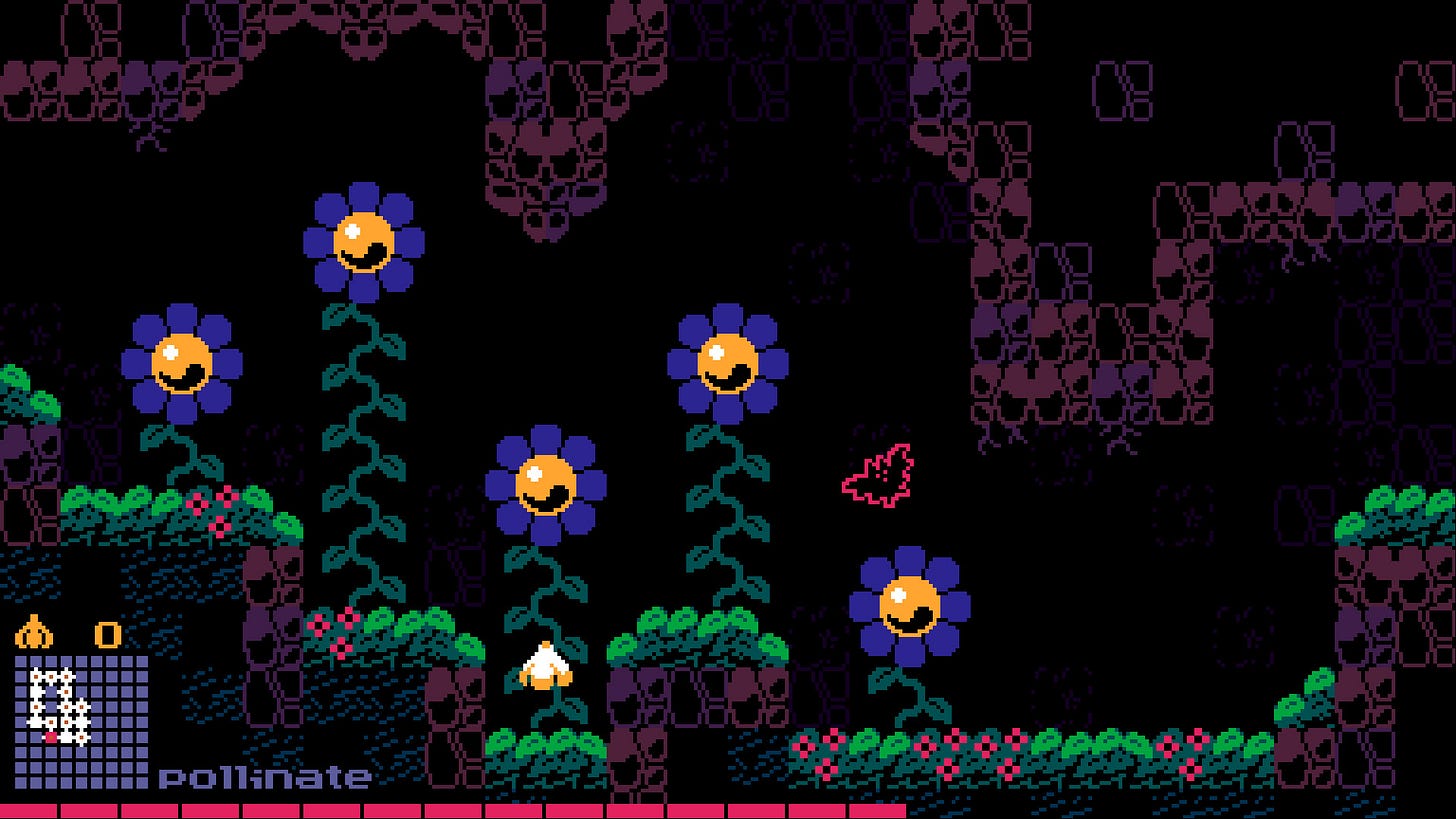SinksAdventure flaps by to talk about making Vampire's Best Friend
A different metroidvania, chosen limitations, and lots of garlic!
Vampire’s Best Friend is an open ended precision “batformer” that released to Steam and itch.io on October 6, 2025. I was very ecstatic when SinksAdventure, the developer for the game, agreed to an interview about the development! There will be spoilers for the game, so please go play it first! Happy reading! - August Poe
August: How long have you been developing games, and how did you start?
Sink: My brother was always really smart with computers and made some simple games with GameMaker before he was even 10 years old. I tried making games too but I was just too stupid hahaha, instead I made a bunch of stop motion animations on the new upcoming website Youtube!
I did that for years but it was never as exciting to me as making games, so when I was a teenager I finally got serious about learning how to program. With a lot of annoying my brother to help me when I’d encounter bugs, I was finally able to make a handful of really crappy games!
Despite their crappiness I stuck with it and have been making games for about 13 years now and was eventually able to make a handful of games that some people seem to think aren’t crappy!
August: Where did the idea for Vampire’s Best Friend originate from?
Sink: The inspiration for VBF was my frustration with metroidvania games always stopping the player from progressing if they haven’t found certain items yet. I always felt that was so antithetical to a genre whose main focus is exploration.
So I tried making a metroidvania where you had all the tools you needed from the very start of the game, and the only thing blocking the player’s progress is their skill and understanding of the core mechanics.
August: Did you ever consider adding more actions, or were you always set on only flapping left or right?
Sink: At first the game actually had an upward lunge attack you could do if you pressed both left and right flap buttons at the same time, but the further along it got I was surprised how much just flying and dodging obstacles could carry the whole game, so there was no need for fighting enemies anymore.
August: With such a specific moveset, how did you come up with so many varied challenges that require all manners of observation and execution?
Sink: Something I keep realizing with games is that you don’t need much to make it fun. In my first big game Crowtel, I would introduce and discard ideas with reckless abandon. But when I worked on Shovel Knight Dig, we had to make hundreds of levels for every area in the game, so we had to do a lot with what we had. No matter how many levels I made with a certain level mechanic, there were always more creative and fun ideas that were possible.
In particular with VBF, I realized the more interesting the player’s controls, the less complicated the levels needed to be for the game to be fun.
I like to use Super Mario 3D world and Super Mario Odyssey as an example of this. In 3D World, Mario has quite simplified movement, and the fun of the game is mostly in its level design, whereas Odyssey’s fun has shifted to Mario’s movement, and the level design is a lot simpler.
August: What was it like to have people playtest a game that has a wide array of challenges? How did you know which ones you wanted to alter and which you’d keep the same?
Sink: I honestly didn’t pull many punches with the designs of the challenges haha! It seemed people could overcome any challenge even if it was really hard because of the frequent checkpoints and quick respawn time. Even my dad who doesn’t game much got the hang of it after a while!
If the player got really stuck on a specific challenge, they would move on to another part of the game (another benefit of making it totally open world!) and return later when they were better at controlling the bat.
August: What do you enjoy about designing a game with self imposed limitations?
Sink: I like limitations because you know there is an upper limit to how good something can be. It helps you be satisfied with a result faster, and forces you to make your game simpler.
More importantly though, I just find the 8bit aesthetic so charming. Not just the pixel art, but the incredibly technical ways developers pushed the limitations of the hardware back then is fascinating to me, and almost feels like a lost art now.
I would love to make an actual NES game that can run on real hardware some day, but it’s just a little too impractical for me to do right now.
August: What was the process for designing challenges that take place over multiple screens?
Sink: Those were really fun to design! I kind of see those as VBF’s equivalent to bosses. There’s one multi-room challenge in every area, and each one tests your mastery of the area’s unique mechanics, like a boss would in a more traditionally structured game.
August: In my playthrough, there were many rooms that once I understood them I was able to overcome other rooms from the knowledge I gained. How do you go about designing knowledge based progression like this?
Sink: Oh that’s great, that was one of the main things the game was trying to achieve so I’m glad to hear it worked out that way for you!
I did my best to facilitate this kind of progression by making sure most levels have 3 or more exits with varying difficulties of reaching each one, but honestly I think this is something that kind of just emerges naturally as you make levels and can’t be done super deliberately.
August: Lighting the candles was a nice added layer to getting garlic, when in development did you add this?
Sink: Thanks! I think it was pretty early on, they helped a lot with making a challenging level that was still easy to navigate if you were just trying to pass through it to get to another part of the map.
August: Why did you decide to let players go anywhere on their own from the beginning?
(I touched on this in the question about where the idea for the game came from)
August: When designing which rooms connect, was there a certain flow of ideas that you wanted to convey to the player?
Sink: Since the game is so open, making sure each level mechanic was introduced to the player in an intuitive way no matter which direction they approached it from was a bit of a challenge. I tried making the level mechanics pretty simple to tell what they do at a glance: a fan blowing air in a specific direction, spinning spike balls, crush traps, bouncy flowers... well ok that one might be a little more abstract haha
August: When in development did you decide to have more garlic than was necessary to complete the game?
Sink: That was definitely decided right from the start, I didn’t see much point in having an open world if every collectable was required to beat the game.
I’m a habitual game replayer, and I love when a game lets me play a bit differently every time, so letting players skip certain areas or just play their favorite parts was important to me.
August: What was the process for making the soundtrack for this game?
Sink: I made the soundtrack using Famitracker, a free tracker which emulates the sound and limitations of the NES’s sound chip.
I’ve been making music for about 5 years now and I actually started learning a little music theory before working on this soundtrack, but honestly I’m usually just composing by intuition.
I see making music by feel as a statistics problem. I’d say for every 5 songs I make, only 1 of them sounds halfway decent hahaha! Thinking about it this way helps me to not get discouraged when a song I’m working on absolutely sucks, because that’s the base case. Every subsequent sucky song I make I know I’m closer to making one that isn’t sucky, statistically!
Lately I see most things in life this way, somehow it helps me cope with failures and disappointment.
August: Which rooms were your favorite to design, and which are your favorite to play?
Sink: One of my favorite levels to design is called Twister I think, it has 4 fans pushing you around in a circle, with 3 different garlic cloves to collect on different laps as you go around.
The big vertical section in the garden area is one of my favorites to play, you get a massive trail of garlic following behind you and you start getting nervous wondering when you’re finally going to reach another spot to perch on!
August: I was always excited to see the different names for the rooms, do you have any that are your favorite?
Sink: Even though I titled them it’s hard for me to remember them all haha, I always liked the room named Circle of Life though. It has some flies circling around a flower and you have to fly up and eat one to get enough energy to reach the other side of the room. I tried not to get too annoying with the puns, but that one was cute to me haha
August: Thank you for your time, is there anything you want to say to fans of Vampire’s Best Friend?
Sink: Thanks for the fun questions!
Well I hope there are some out there, reaching an audience has never been my strong suit haha
I’d like to know their thoughts on metroidvanias after playing VBF. Does my take on the genre seem like a better approach, or maybe VBF is a different genre entirely, or maybe there’s some other option I haven’t thought of. I’m just surprised there are so few games structured in a similar way and would love to hear why people think that is.
Steam - https://store.steampowered.com/app/3583530/Vampires_Best_Friend/
itch.io - https://sink.itch.io/vampires-best-friend





